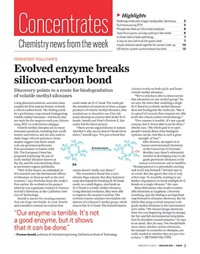Advertisement
Grab your lab coat. Let's get started
Welcome!
Welcome!
Create an account below to get 6 C&EN articles per month, receive newsletters and more - all free.
It seems this is your first time logging in online. Please enter the following information to continue.
As an ACS member you automatically get access to this site. All we need is few more details to create your reading experience.
Not you? Sign in with a different account.
Not you? Sign in with a different account.
ERROR 1
ERROR 1
ERROR 2
ERROR 2
ERROR 2
ERROR 2
ERROR 2
Password and Confirm password must match.
If you have an ACS member number, please enter it here so we can link this account to your membership. (optional)
ERROR 2
ACS values your privacy. By submitting your information, you are gaining access to C&EN and subscribing to our weekly newsletter. We use the information you provide to make your reading experience better, and we will never sell your data to third party members.
Persistent Pollutants
Reactions: Recognizing Lawrence Knox and being precise about silicon-carbon bonds
March 14, 2024
| A version of this story appeared in
Volume 102, Issue 8
Letters to the editor
Profiles of Black chemists
I was pleased to read your profiles of Black chemists, which I rediscovered in a link from the C&EN weekly newsletter of Feb. 14. I suggest that the next time you update this article, you add organic chemist Lawrence Knox.
As a graduate student at Harvard University in the late 1930s, he confirmed that bridged bicyclic compounds with a halogen atom at a bridgehead carbon failed to undergo substitution reactions by either the SN1 or SN2 mechanisms, as previously predicted. At the Hickrill Chemical Research Foundation in New York, he and William Doering were the first to synthesize the tropylium ion and showed that it was remarkably stable, as previously predicted by Erich Hückel’s theory of aromaticity. You can find a more complete story about him at sciencehistory.org/stories/magazine/chemical-relations-william-and-lawrence-knox-african-american-chemists.
Robert B. Grossman
Lexington, Kentucky
Breaking silicon-carbon bonds
Do silicone polymers degrade in the environment? The quotation by professor Frances Arnold in the article on breaking silicon-carbon bonds(C&EN, Feb. 5, 2024, page 3) would suggest the answer is no.
“There are no organosilicons in nature. And that’s why nature doesn’t break them down,” Arnold says in the article.
Yet decades of research, ironically a lot of which was performed by Dow silicones or the predecessor company Dow Corning, show that both hydrolysis of Si-O-Si linkages and oxidation of Si-CH3groups occur. For example, metabolites of the siloxanes (Me2SiO)5 (also known as D5) and Me3SiOSiMe3(also known as MM) in mammals (Drug Metab. Dispos. 2003, DOI: 10.1124/dmd.31.2.206) and Me2Si(OH)2in bacteria (J. Polym. Environ. 2003, DOI: 10.1023/A:1026056129717) exhibit both C–H and Si–C oxidation. Environmental oxidation of Si–C bonds in silicones is also facile, as shown through many studies that identify the important role of hydroxy and other radicals in the mechanism of breakdown (ibid.; Environ. Sci. Technol. 2020, DOI: 10.1021/acs.est.0c01368). Like most molecules, including polymers, there are benefits and detriments. One of the benefits of silicone polymers is their ability to undergo rapid hydrolytic cleavage and slower oxidative cleavage of Si–C bonds to give silica, water, and carbon dioxide over a few years in nature.
Michael A. Brook
Ancaster, Ontario
The following is a response by two of the authors of the Science paper that the C&EN article was based on:
We are of course aware of the chemical mechanisms for siloxane degradation in the environment, as we indicated in the paper (Science 2024, DOI: 10.1126/science.adi5554), as well as in the accompanying blog post (caltech.edu/about/news/teaching-nature-to-break-man-made-chemical-bonds).
The various studies shared by the reader on possible examples of biological Si–C bond cleavage were also cited in our paper. For bacteria, we recommend the exhaustive review “Are Si–C Bonds Cleaved by Microorganisms? A Critical Review on Biodegradation of Methylsiloxanes,” in which it is stated that “no convincing demonstration of Si–C cleavage by native environmental microorganisms has been found” (Chemosphere 2023, DOI: 10.1016/j.chemosphere.2023.137858).
Our paper describes the first enzyme that cleaves Si–C bonds. The quote to which the reader objects should be taken in the context of the paper rather than a very short article describing the paper.
Frances H. Arnold and Ryen O’Meara
Pasadena, California




Join the conversation
Contact the reporter
Submit a Letter to the Editor for publication
Engage with us on Twitter